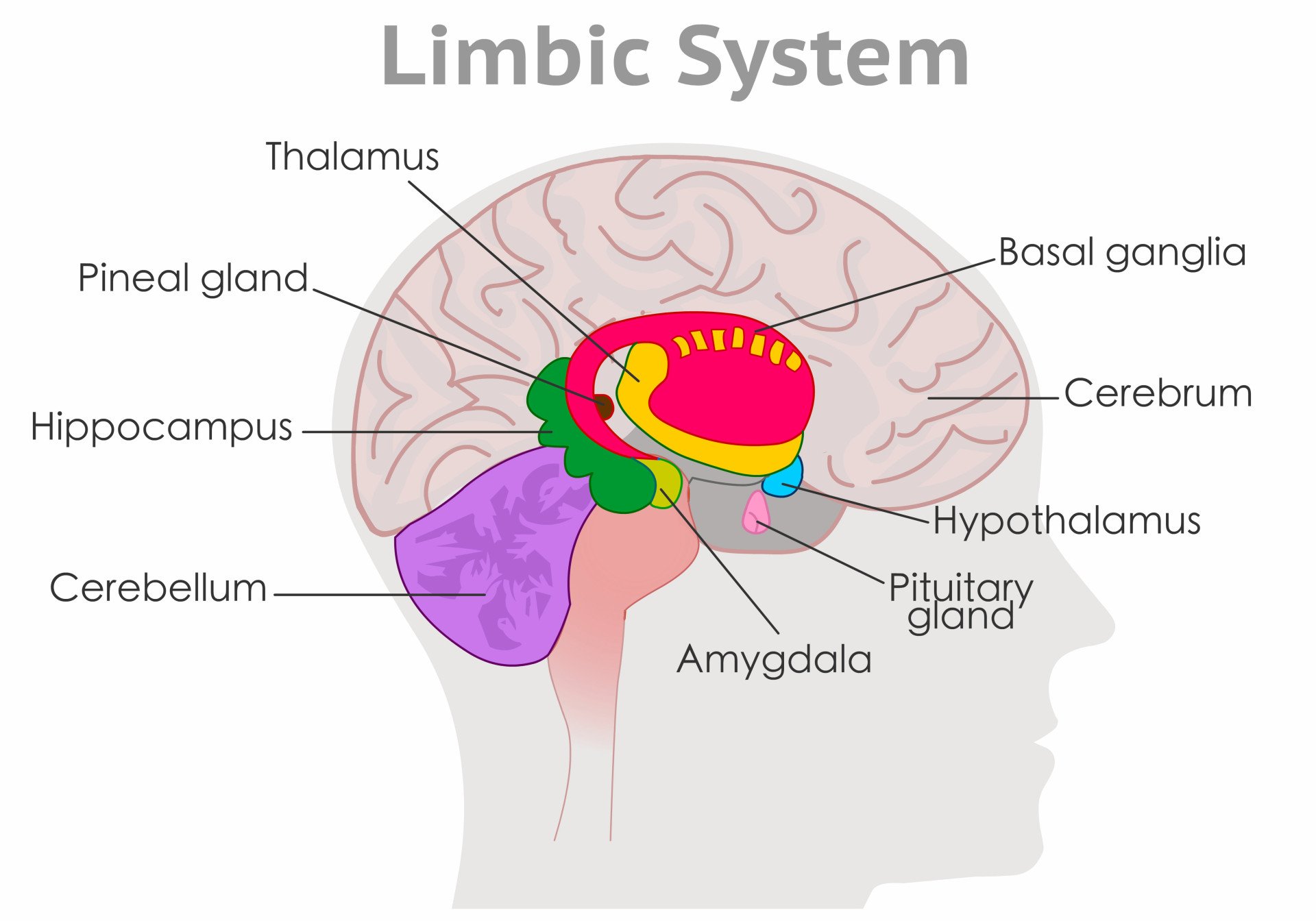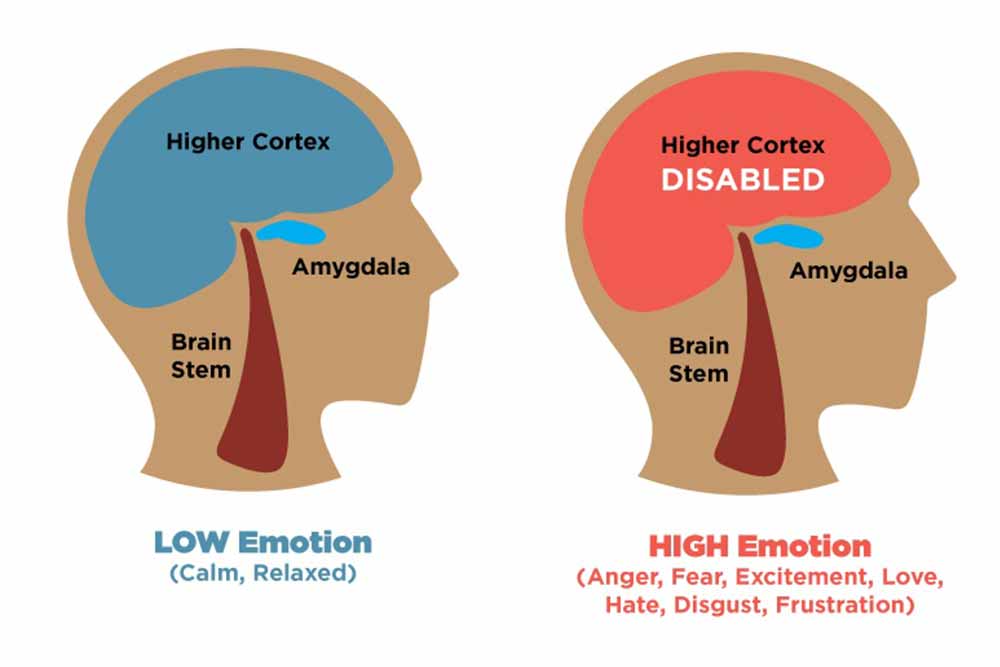- Amygdala hijack is an emotional overreaction response to stress. This activates the fight-or-flight response and disables one’s rational, reasoned response.
- Amygdala hijack can happen to anyone and is usually triggered by something, causing the amygdala to ‘disable’ the frontal lobes and take control of your emotional responses.
- Sometimes we have suppressed emotions that suddenly become prominent when triggered by past memories, which then results in activation of the fight or flight response.
- This triggering can result in inappropriate or irrational behavior, such as shouting at someone you care about.
- After the amygdala hijack, we may feel emotions of shame, embarrassment, or guilt.
The Role of the Amygdala
Daniel Goleman first coined the term amygdala hijack in his 1995 book titled Emotional Intelligence: Why It Can Matter More Than IQ.
Goleman’s term aims to recognize that we have an ancient structure, the amygdala, that is designed to respond swiftly to a threat, whether the threat is real to survival or not.
The amygdala is an almond-shaped structure situated in the mid-brain, forming part of the limbic system.
This structure is known as the emotional hub of the human brain and plays a role in fear and the fight-or-flight response.

The amygdala is considered a part of the limbic system within the brain and is key to how we process strong emotions like fear or pleasure.
Human ancestors developed this response to deal with threats and dangerous situations, to release stress hormones that prepare the body to either face a threat or flee from it.
The cerebral cortex evolved long after the limbic system and gave us logical reasoning. Whilst the amygdala may work automatically, the frontal lobes of the cortex allow people to process and think about their emotions so they can make logical decisions to avoid conflict.
Today, common human threats tend to differ from those experienced by human ancestors, such as work and life stressors or being anxious about social situations.
The amygdala, however, cannot differentiate between physical and emotional threats, so in the situation of experiencing sudden stress at work, this could trigger the amygdala to automatically respond before your frontal lobes have had a chance to provide any logical reasoning to the situation.
Amygdala hijack can be useful in some life-threatening situations, such as causing us to move out of the way of a car traveling towards us before we have even registered that the car was there.
However, in other situations, amygdala hijack can cause us to react in an intense, emotional way which may be out of proportion to the situation.
For instance, experiencing a co-worker who keeps trying to talk to you while you are trying to concentrate on work could trigger the amygdala to take over and result in you shouting at them.
Without the ability of the frontal lobes, we would be unable to think clearly, so we may not be in control of our responses.
Causes
In the normal context, when sensing something in the environment, the sensory information gets sent to the thalamus, a primitive part of the brain that acts as the brain’s relay station.
The thalamus relays the sensory information to the frontal lobes of the cortex, a center for higher brain functions such as perception, decision-making, and language.
The cortex then processes the sensory signals from the thalamus and applies logical reasoning. For the involvement of emotions, this processed signal is sent to the amygdala.
The amygdala will then produce appropriate emotional responses followed by a flood of hormones and enzymes released to create suitable emotions and actions.
When a threat is sensed, the amygdala may automatically activate the fight-or-flight response.
However, the frontal lobes process the information to determine if the threat is real and what a logical response would be. If the threat is determined to be not serious, the frontal lobes tend to take control, and this results in people responding in a thought-out way.
This process is different during an amygdala hijack. During a hijack, the sensations from the environment still reach the thalamus.
However, the thalamus understands that in some threatening conditions, involving logical reasoning would be a waste of time.
Thus, the thalamus bypasses the cortex and projects straight to the amygdala, expecting an instant action to prevent the threat.
In the amygdala, a flood of hormones and enzymes are released, creating emotions and actions that may be considered out of proportion to the situation.
The amygdala initiates the fight-or-flight response before the cortex has had a chance to overrule it. This cascade of events triggers the release of stress hormones, including epinephrine and cortisol.
The frontal lobes can often override the amygdala for mild or moderate threats, but amygdala hijack occurs for those considered serious threats. The types of threats and their severity differ from person to person.
For instance, many people may be able to control their emotional reactions when they receive harsh criticism from their boss and respond in a calm manner (this would be a mild threat to them).
However, for others, this criticism may trigger them to the extent that they have an emotional overreaction response and end up shouting at their boss (this would be a serious threat to them).
The immediate result of the amygdala hijack is that there is a depreciation in working memory.
The hijack causes people to narrow their ability to see more than one solution to a threat. Within a few seconds, when the hijack pathway is completed, this is when people may start questioning themselves, such as ‘What was I thinking?’.
With no contribution from the frontal lobes, the thought processes ceased in the moment, so there was no rational thinking. This explains why people may express that they cannot ‘think’ when emotionally overwhelmed or distressed.
Hijacks are often mistakes, as described by Goleman. They can be sudden, emotional, negative emotions or doing something which leads to regret.
Psychological threats that can trigger amygdala hijack are pressures and stressors of modern life, work, and relationships. Anger, aggression, anxiety, and fear are also common emotional triggers.
Emotional triggers can differ for everyone. Some people may have experienced adverse life events or trauma, which means they hold suppressed emotions.
So, if something in their current life reminds them of these past events, they may be more likely to have an amygdala hijack.
Since the amygdala is located close to the hippocampus (a structure responsible for storing memories), these two structures may interact with each other when an emotional memory is triggered.
Symptoms
An amygdala hijack occurs as part of the fight or flight response being triggered, meaning that similar physical symptoms of this response will occur during a hijack:
- Rapid heart rate
- Clammy skin
- Dilated pupils to improve vision for faster responses
- Sweating
- Goosebumps on the skin
- Increased blood sugar – for immediate energy
- Contracted blood vessels allow the body to redirect blood to major muscle groups
- Airways expand to allow in and use more oxygen
The result of amygdala hijack can an emotional overreaction response to a perceived threat. It can then take several seconds for this reaction to dissipate before one can have better control over their amygdala.
The individual may also find they cannot think clearly during a hijack. After the hijack, it is common for individuals to feel embarrassed or regretful.
Amygdala hijack and mental health
The amygdala is commonly found to be associated with mental health conditions, specifically those involving anxiety. Fear and avoidance, which are common to anxiety disorders, could be related to an overactive amygdala and more hijacks.
Hyperactivation in the amygdala was frequently observed in those with social anxiety disorder and specific phobias (Etkin, Tor, & Wager, 2007).
This might make sense since those with social or specific phobias often present irrational and strong emotional reactions to the things and situations they fear.
Likewise, greater amygdala activation and increased emotional responses have been observed in those with panic disorder, posttraumatic stress disorder, and obsessive-compulsive disorder.
Developmental studies have found that the amygdala is particularly sensitive to stress in early life. Experiencing early life trauma or childhood mistreatment is believed to significantly affect the stress response (Yan, 2012).
Experiencing childhood adversity can also produce long-lasting structural and functioning changes in the amygdala, also affecting the hormones involved in the amygdala hijack.
As a result, the threshold for emotional reactions in these children is lowered due to repeated sensitization of amygdala circuits. This means that they can be overly sensitive to stressors, resulting in heightened activation of the neural circuits in stress.
It is also suggested that those who experienced childhood maltreatment were at a higher risk of developing anxiety-related disorders (Adamec & Shallow, 2000).
Thus, it could be that those who experienced adverse childhoods have more amygdala hijacks, overreact to stress, and have difficulty regulating their emotions.
Aside from mental health conditions, chronic stress can also play a role in the functioning of the fear circuits in the brain, meaning there may be a greater chance of amygdala hijacking.
Neuroimaging studies have shown that the amygdala is structurally and functionally altered by psychosocial stress and stress exposure (Roozendaal et al., 2009).
Chronic stress can also reduce the functioning of other areas of the brain that work to inhibit fear, such as the hippocampus and the medial prefrontal cortex.
Since chronic stress can cause more amygdala hijacks and can inhibit the hippocampus, it can also result in subsequent problems with short-term memory.
How to Manage amygdala hijack
Amygdala hijacking is often inevitable and can happen to anyone. It cannot always be prevented, but the key is to be aware of when it is happening and learn how to respond to it in a healthy way rather than being quick to react.
Goleman proposed that in order to manage amygdala hijacks, people must increase their emotional intelligence.
He proposed five essential competencies for increasing emotional intelligence: self-awareness, self-regulation, motivation, empathy, and social skills.
- Self-awareness:
Being self-aware is the ability to recognize a feeling as it is happening. In order to prevent the amygdala from overriding rational thought, a person must identify an emotional response and manage its control over the situation. Self-awareness gives people the skills to distinguish between helpful and unhelpful emotions. - Self-regulation:
To be able to self-regulate means that emotions can be managed. It is the ability to connect to, or process emotions first before reacting. People who can self-regulate can respond logically with cognitive thought instead of reacting emotionally without forethought. An emotionally intelligent person can recognize when a hijack is coming and attempt to prevent an undesired reaction. - Motivation:
An emotionally intelligent person, according to Goleman, is someone who strives to satisfy their intrinsic motivation in work and other activities, regardless of external incentives. - Empathy:
An empathetic person can recognize the emotions in others. Through this, people can be understanding, aware of, and sensitive to others’ feelings and work to utilize this ability to manage their own emotions, promote healthy emotions, as well as coming to a positive result in a conflict. - Social skills:
According to Goleman, those who are emotionally intelligent are good at interpersonal communication. Those with strong social skills should be able to have good conflict-resolution skills. Thus, in times when a conflict may arise, those with strong social skills can react and respond to others in a positive way.
Mindfulness
Mindfulness is another method that can be utilized to prevent amygdala hijack. Mindfulness is the ability to be fully present in the moment, aware of the self, where one is, and what one feels.
In a way, mindfulness employs similar techniques to the competencies of emotional intelligence proposed by Goleman. In this way, mindfulness could also improve a person’s emotional intelligence.
Mindfulness is usually a technique that needs regular practicing for better effects, rather than just implementing the techniques when about to experience an amygdala hijack.
One way to help to focus during mindfulness practice is to actively control breathing, focusing on how the body responds to the breath.
Practicing mindfulness can help people to control the body’s responses better when experiencing a reaction and helps individuals to feel more present in the moment and engaged in responses.
Stress management
Being able to manage stress, in general, may help prevent amygdala hijacks from occurring. It may be useful for some to make themselves aware of what their stressors or triggers are.
These could be small or large triggers. Making a note of when everyday stressors turns into chronic stress can help with identifying ways to manage this stress.
Effective stress management can include fast-acting relievers such as breathing exercises, which can bring immediate relief. As well as this, general healthy habits can be utilized to reduce overall stress, such as regular exercise, meditation, and using a journal.
Coping with amygdala hijack
Whilst using preventative measures to ensure amygdala hijacks do not happen, there are times when these situations can still occur.
When someone may feel that an amygdala hijack may be happening, there are some methods to help cope with the situation.

Name the emotion
Recognizing and naming the emotion when it happens can shift connections back to the frontal lobes since this requires the use of language and analysis. Even simply stating ‘I am mad’ could be enough to make this feeling less intense and bring back a rational mindset.
6-second rule
It can take the chemical involved in the amygdala response to dissipate. Therefore, delaying any kind of response for about 6 seconds could prevent the amygdala from taking control and causing an emotional reaction.
Whilst delaying the response, this time could be used for taking the time to think about something positive or to focus on breathing.
Breathing
Breathing can be a powerful tool during a heightened situation as it can trigger the parasympathetic nervous system to bring about a restful bodily response. Taking control of breathing in stressful situations can allow thoughtful decisions which are not driven by emotions.
Change the setting
By getting up and moving around in stressful situations, the surroundings are automatically considered, which reactivates the thinking part of the brain.
Also, taking some time out away from the stressful situation in times of feeling out of control can help individuals to get a better hold of their emotions and see things from a rational perspective.
Share the mental load
When feeling a lot of emotions, sharing feelings with a trusted person can split the mental load and help our amygdala feel less threatened. Likewise, the use of language in highly emotional situations encourages the use of the thinking part of the brain.
Draw on mindfulness
While practicing mindfulness may be important, drawing on the techniques used in practice can help someone move away from negative internal feelings and back to the present by paying attention to the surroundings.
Considerations
It is important to remember that amygdala hijack may not be preventable in every situation and that it is realistic to expect setbacks. When these happen, it may be useful to take some time to acknowledge the actions of what happened and reflect on this.
This can help shift towards a mindful way of viewing the experience and may provide some useful insight into how to avoid this situation again next time.
References
Adamec, R., & Shallow, T. (2000). Rodent anxiety and kindling of the central amygdala and nucleus basalis. Physiology & behavior, 70(1-2), 177-187.
Etkin, A., & Wager, T. D. (2007). Functional neuroimaging of anxiety: a meta-analysis of emotional processing in PTSD, social anxiety disorder, and specific phobia. American journal of Psychiatry, 164(10), 1476-1488.
Goleman D. (2005). Emotional intelligence: Why it can matter more than IQ. New York, NY: Bantam Books.
Howell, T. J. (2014). Daniel Goleman–Emotional Intelligence. University of Denver University College.
Hughes, K. C., & Shin, L. M. (2011). Functional neuroimaging studies of post-traumatic stress disorder. Expert review of neurotherapeutics, 11(2), 275-285.
Kulkarni, M. (2014). Amygdala: A Beast to Tame.
Roozendaal, B., McEwen, B. S., & Chattarji, S. (2009). Stress, memory and the amygdala. Nature Reviews Neuroscience, 10(6), 423-433.
Yan, X. (2012). Amygdala, childhood adversity and psychiatric disorders. The Amygdala: A Discrete Multitasking Manager, 303.



